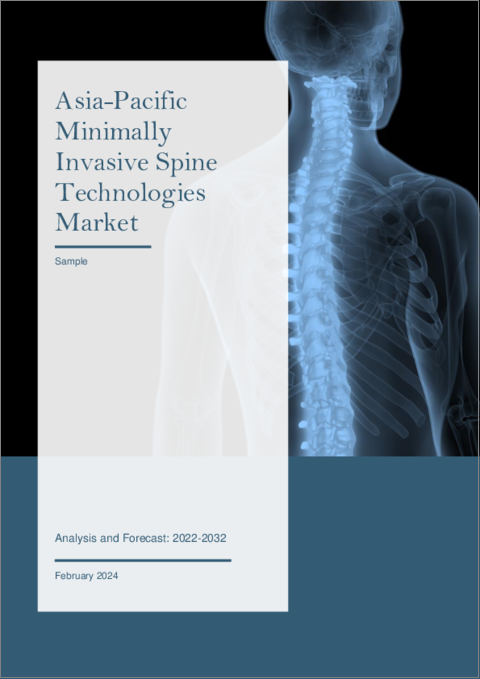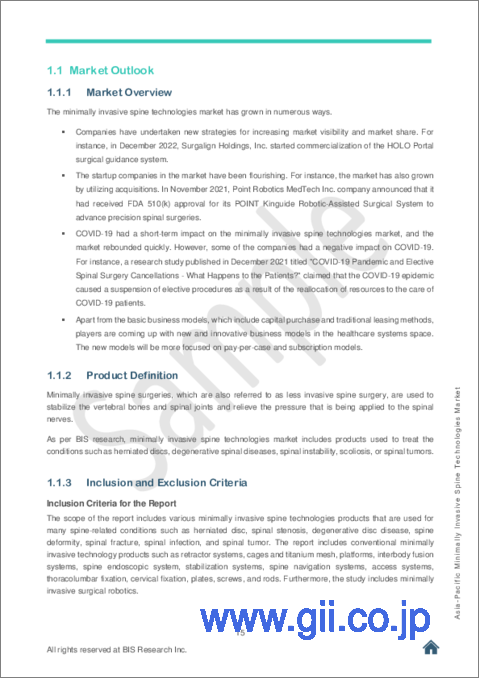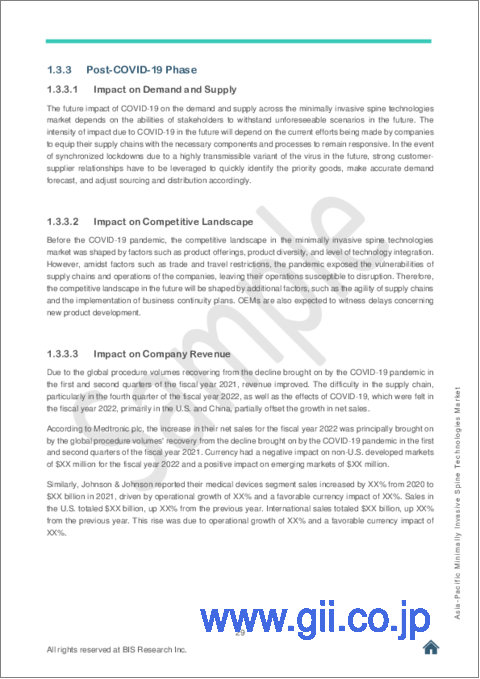|
|
市場調査レポート
商品コード
1424901
アジア太平洋地域の低侵襲脊椎技術市場の分析・予測:2022~2032年Asia-Pacific Minimally Invasive Spine Technologies Market: Analysis and Forecast, 2022-2032 |
||||||
カスタマイズ可能
|
|||||||
| アジア太平洋地域の低侵襲脊椎技術市場の分析・予測:2022~2032年 |
|
出版日: 2024年02月15日
発行: BIS Research
ページ情報: 英文 86 Pages
納期: 1~5営業日
|
全表示
- 概要
- 図表
- 目次
アジア太平洋地域の低侵襲脊椎技術の市場規模は、2022年の6億4,480万米ドルから、予測期間中は11.95%のCAGRで推移し、2032年には19億9,420万米ドルの規模に成長すると予測されています。
同市場は、世界で低侵襲脊椎手術の採用が増加していることや、シミュレーション、トレーニング、生涯医学教育の重要性に関する医療従事者の意識が高まっていることなどから、成長が予測されています。
アジア太平洋地域の低侵襲脊椎技術市場:イントロダクション
| 主要市場統計 | |
|---|---|
| 予測期間 | 2022-2032年 |
| 2022年評価 | 6億4,480万米ドル |
| 2032年予測 | 19億9,420万米ドル |
| CAGR | 11.95% |
アジア太平洋地域の低侵襲脊椎技術市場は、低侵襲脊椎手術が好まれる傾向の拡大と、シミュレーション、トレーニング、生涯医学教育の重要性に関する医療従事者の意識の高まりにより、大幅な成長を遂げています。医療技術の革新により、侵襲性を低減した脊椎介入への新たなアプローチが可能になり、回復時間の短縮、術後疼痛の軽減、組織損傷の最小化などの利点を患者に提供しています。
また、アジア太平洋地域全体で脊椎関連疾患の発生率が増加し、高齢化人口が拡大していることも市場に影響を及ぼしています。患者の転帰を改善し、医療支出を抑制することに重点を置く同地域では、低侵襲脊椎技術の採用が継続的に拡大しています。この動向は脊椎治療の展望を再形成し、同地域の医療提供の全体的強化に貢献しています。
当レポートでは、アジア太平洋地域の低侵襲脊椎技術の市場を調査し、市場概要、市場成長への各種影響因子の分析、特許動向、臨床試験の動向、法規制環境、市場規模の推移・予測、主要国別の詳細分析、主要企業の分析などをまとめています。
市場の分類
セグメンテーション1:国別
- 日本
- 中国
- インド
- オーストラリア
- 韓国
- その他
目次
エグゼクティブサマリー
調査範囲
調査手法
第1章 市場
- 市場の見通し
- 市場概要
- 製品の定義
- 包含基準と除外基準
- 主な調査結果
- 前提条件と制限事項
- 市場成長シナリオ
- 業界の展望
- 主要動向
- 機会の評価
- 特許分析
- 製品ベンチマーキング
- 臨床試験
- 低侵襲脊椎技術に対するCOVID-19の影響
- 事業力学
- 影響分析
- 事業促進要因
- 事業上の制約
- 事業機会
第2章 低侵襲脊椎技術市場(地域別)
- アジア太平洋
- 規制の枠組み
- 主要な調査結果と機会の評価
- 市場力学
- 市場規模・予測分析
第3章 競合ベンチマーキング・企業プロファイル
- 競合情勢
- 主要戦略・展開
List of Figures
- Figure 1: Minimally Invasive Spine Surgery Techniques
- Figure 2: Asia-Pacific Minimally Invasive Spine Technologies Market, $Million, 2021-2032
- Figure 3: Minimally Invasive Spine Technologies Market (by Region), $Million, 2022 and 2032
- Figure 4: Minimally Invasive Spine Technologies Market, Market Dynamics
- Figure 5: Minimally Invasive Spine Technologies Market: Research Methodology
- Figure 6: Primary Research
- Figure 7: Secondary Research
- Figure 8: Bottom-Up Approach (Segment-Wise Analysis)
- Figure 9: Top-Down Approach (Segment-Wise Analysis)
- Figure 10: Assumptions and Limitations
- Figure 11: Minimally Invasive Spine Technologies Market Size and Growth Potential (Realistic Growth Scenario), $Million, 2021-2032
- Figure 12: Minimally Invasive Spine Technologies Market Size and Growth Potential (Optimistic Scenario), $Million, 2021-2032
- Figure 13: Minimally Invasive Spine Technologies Market Size and Growth Potential (Pessimistic Scenario), $Million, 2021-2032
- Figure 14: Minimally Invasive Spine Technologies Market, Key Trends
- Figure 15: Minimally Invasive Spine Technologies Market, Key Trends, Market Shift, 2022-2032
- Figure 16: Minimally Invasive Spine Technologies Market, Patent Analysis (by Country), January 2018-January 2023
- Figure 17: Minimally Invasive Spine Technologies Market, Patent Analysis (by Year), January 2018-January 2023
- Figure 18: Minimally Invasive Spine Technologies Market, Impact Analysis
- Figure 19: Incidence of Degenerative Spine Disease, by Region, 2018
- Figure 20: Geriatric Population Growth, by Region, 2019 vs. 2050
- Figure 21: Prevalence of Spinal Degeneration (by Age), 2021
- Figure 22: Next-Generation Products for Minimally Invasive Spine Surgery
- Figure 23: Relative Comparison of Operative Factors in 2-Dimensional Versus 3-Dimensional Minimally Invasive Spine Surgery
- Figure 24: Cost of Robotic-Assisted Systems Used in Spine Surgery
- Figure 25: Artificial Intelligence Improving the Quality and Delivery of Care
- Figure 26: Minimally Invasive Spine Technologies Market Share (by Region), 2021 and 2032
- Figure 27: Asia-Pacific Minimally Invasive Spine Technologies Market Incremental Opportunity (by Country), $Million, 2021-2032
- Figure 28: Asia-Pacific Minimally Invasive Spine Technologies Market, $Million, 2021-2032
- Figure 29: Asia-Pacific Minimally Invasive Spine Technologies Market (by Country), % Share, 2021 and 2032
- Figure 30: Japan Minimally Invasive Spine Technologies Market, $Million, 2021-2032
- Figure 31: China Minimally Invasive Spine Technologies Market, $Million, 2021-2032
- Figure 32: Australia Minimally Invasive Spine Technologies Market, $Million, 2021-2032
- Figure 33: India Minimally Invasive Spine Technologies Market, $Million, 2021-2032
- Figure 34: South Korea Minimally Invasive Spine Technologies Market, $Million, 2021-2032
- Figure 35: Rest-of-Asia-Pacific Minimally Invasive Spine Technologies Market, $Million, 2021-2032
- Figure 36: Share of Key Developments and Strategies, January 2018-January 2023
- Figure 37: Regulatory and Legal Activities, January 2018-January 2023
- Figure 38: New Offerings, January 2018-January 2023
- Figure 39: Mergers and Acquisitions, January 2018-January 2023
- Figure 40: Partnerships, Alliances, and Business Expansions, January 2018-January 2023
List of Tables
- Table 1: Key Challenges and Possible Solutions for Players in the Minimally Invasive Spine Technologies Market
- Table 2: Minimally Invasive Spine Technologies Market, Quarterly Key Developments Analysis, January 2018-January 2023
- Table 3: Key Questions Answered in the Report
- Table 4: Parameters for Realistic, Optimistic, and Pessimistic Growth Scenarios
- Table 5: Minimally Invasive Spine Technologies Market, Awaited Technologies
- Table 6: Minimally Invasive Spine Technologies Market, Product Benchmarking
- Table 7: Minimally Invasive Spine Technologies Market, Ongoing Clinical Trials
- Table 8: Asia-Pacific Minimally Invasive Spine Technologies Market, Regulatory Framework
- Table 9: Asia-Pacific Minimally Invasive Spine Technologies Market, Impact Analysis
The Asia-Pacific Minimally Invasive Spine Technologies Market Expected to Reach $1,994.2 Million by 2032
Introduction to Asia-Pacific Minimally Invasive Spine Technologies Market
| KEY MARKET STATISTICS | |
|---|---|
| Forecast Period | 2022 - 2032 |
| 2022 Evaluation | $644.8 Million |
| 2032 Forecast | $1,994.2 Million |
| CAGR | 11.95% |
The Asia-Pacific minimally invasive spine technologies market was valued at $644.8 million in 2022 and is anticipated to reach $1,994.2 million by 2032, witnessing a CAGR of 11.95% during the forecast period 2022-2032. The minimally invasive spine technologies market is projected to experience growth due to increasing adoption of minimally invasive spine surgeries worldwide and heightened awareness among medical professionals regarding the importance of simulation, training, and ongoing medical education.
Market Introduction
The Asia-Pacific (APAC) Minimally Invasive Spine Technologies Market is witnessing substantial growth, driven by a rising preference for less invasive spinal procedures and increased awareness among healthcare professionals regarding the importance of simulation, training, and continuous medical education. Innovations in medical technologies are enabling novel approaches to spinal interventions with reduced invasiveness, offering patients advantages such as shorter recovery times, reduced postoperative pain, and minimized tissue damage.
The market is responding to a growing incidence of spine-related disorders and an expanding aging population across the APAC region. With a focus on improving patient outcomes and controlling healthcare expenditures, the adoption of minimally invasive spine technologies in APAC is poised for ongoing expansion. This trend is reshaping the landscape of spinal interventions and contributing to the overall enhancement of healthcare delivery in the region.
Market Segmentation:
Segmentation 1: by Country
- Japan
- China
- India
- Australia
- South Korea
- Rest-of-Asia-Pacific
How can this report add value to an organization?
Growth/Marketing Strategy: The APAC minimally invasive spine technologies market has seen major developments by key players operating in the market, such as partnerships, collaborations and business expansions, mergers and acquisitions, product launches, and funding activities. The favored strategy for the companies has been new offerings in the minimally invasive spine technologies market.
Competitive Strategy: Key players in the APAC minimally invasive spine technologies market analyzed and profiled in the study involve players that offer surgical systems, instruments, and systems. Moreover, a detailed market share analysis of the players operating in the APAC minimally invasive spine technologies market has been done to help the reader understand how players stack against each other, presenting a clear market landscape. Additionally, comprehensive competitive strategies such as partnerships, agreements, and collaborations will aid the reader in understanding the untapped revenue pockets in the market.
Table of Contents
Executive Summary
Scope of the Study
Research Methodology
1 Markets
- 1.1 Market Outlook
- 1.1.1 Market Overview
- 1.1.2 Product Definition
- 1.1.3 Inclusion and Exclusion Criteria
- 1.1.4 Key Findings
- 1.1.5 Assumptions and Limitations
- 1.1.6 Market Growth Scenario
- 1.1.6.1 Realistic Growth Scenario
- 1.1.6.2 Optimistic Growth Scenario
- 1.1.6.3 Pessimistic Growth Scenario
- 1.2 Industry Outlook
- 1.2.1 Key Trends
- 1.2.2 Opportunity Assessment
- 1.2.3 Patent Analysis
- 1.2.3.1 Awaited Technological Developments
- 1.2.3.2 Patent Filing Trend (by Country)
- 1.2.3.3 Patent Filing Trend (by Year)
- 1.2.4 Product Benchmarking
- 1.2.5 Clinical Trials
- 1.3 Impact of COVID-19 on the Minimally Invasive Spine Technologies
- 1.3.1 Pre-COVID-19 Phase
- 1.3.2 During COVID-19
- 1.3.3 Post-COVID-19 Phase
- 1.3.3.1 Impact on Demand and Supply
- 1.3.3.2 Impact on Competitive Landscape
- 1.3.3.3 Impact on Company Revenue
- 1.4 Business Dynamics
- 1.4.1 Impact Analysis
- 1.4.2 Business Drivers
- 1.4.2.1 Increasing Incidences and Prevalence of Spinal Disorders
- 1.4.2.2 Increasing Preference for Minimally Invasive Spine Surgeries
- 1.4.2.3 Technological Advancement in Minimally Invasive Spine Surgical Procedures
- 1.4.3 Business Restraints
- 1.4.3.1 Lack of Well-Established Landscape for Reimbursement for Minimally Invasive Spinal Procedures
- 1.4.3.2 Factors Hindering the Implementation of Minimally Invasive Spinal Surgeries
- 1.4.3.2.1 High Cost of Capital Equipment Purchases and Disposables
- 1.4.3.2.2 Lack of Training Leading to Shortage of Skilled Professionals
- 1.4.4 Business Opportunities
- 1.4.4.1 Augmentation of Artificial Intelligence in Minimally Invasive Spine Surgery
- 1.4.4.2 Leveraging Synergies to Diversify Business Portfolio
2 Minimally Invasive Spine Technologies Market (by Region)
- 2.1 Asia-Pacific
- 2.1.1 Regulatory Framework
- 2.1.2 Key Findings and Opportunity Assessment
- 2.1.3 Market Dynamics
- 2.1.3.1 Impact Analysis
- 2.1.4 Market Sizing and Forecast Analysis
- 2.1.4.1 Asia-Pacific Minimally Invasive Spine Technologies Market (by Country)
- 2.1.4.1.1 Japan
- 2.1.4.1.1.1 Market Dynamics
- 2.1.4.1.1.2 Market Size and Forecast
- 2.1.4.1.2 China
- 2.1.4.1.2.1 Market Dynamics
- 2.1.4.1.2.2 Market Size and Forecast
- 2.1.4.1.3 Australia
- 2.1.4.1.3.1 Market Dynamics
- 2.1.4.1.3.2 Market Size and Forecast
- 2.1.4.1.4 India
- 2.1.4.1.4.1 Market Dynamics
- 2.1.4.1.4.2 Market Size and Forecast
- 2.1.4.1.5 South Korea
- 2.1.4.1.5.1 Market Dynamics
- 2.1.4.1.5.2 Market Size and Forecast
- 2.1.4.1.6 Rest-of-Asia-Pacific
- 2.1.4.1.6.1 Market Dynamics
- 2.1.4.1.6.2 Market Size and Forecast
- 2.1.4.1.1 Japan
- 2.1.4.1 Asia-Pacific Minimally Invasive Spine Technologies Market (by Country)
3 Competitive Benchmarking and Company Profiles
- 3.1 Competitive Landscape
- 3.1.1 Key Strategies and Developments
- 3.1.1.1 Regulatory and Legal Activities
- 3.1.1.2 New Offerings
- 3.1.1.3 Mergers and Acquisitions
- 3.1.1.4 Partnerships, Collaborations, and Business Expansions
- 3.1.1 Key Strategies and Developments





